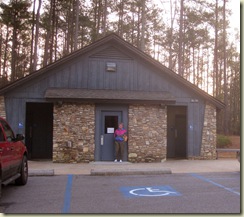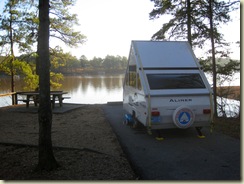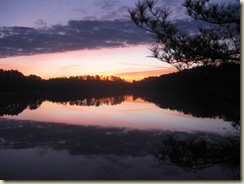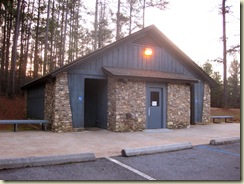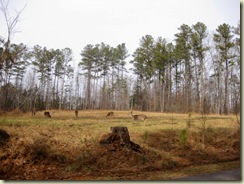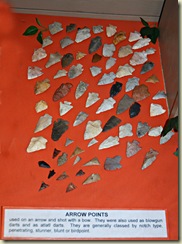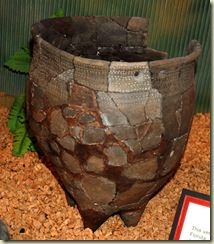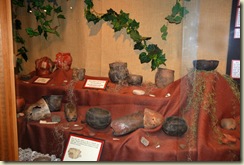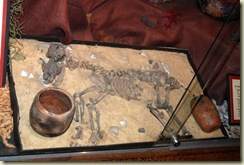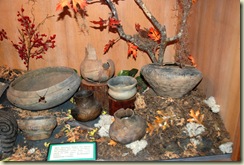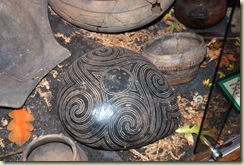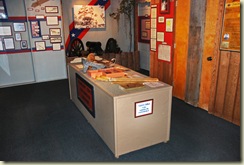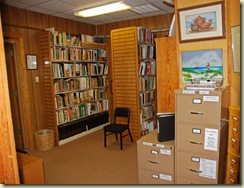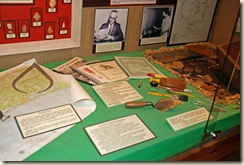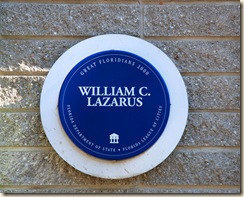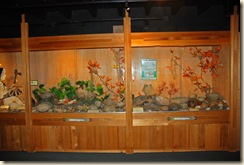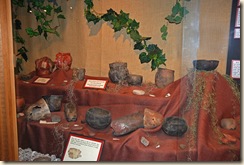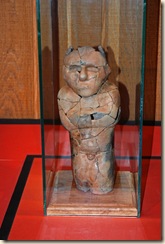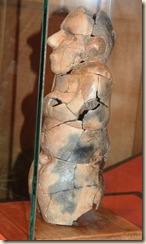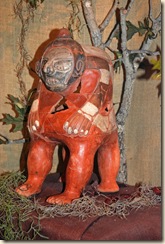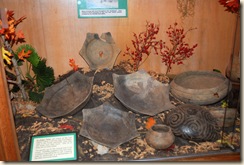Click here for the first post in this series.
This is the last post in this series. It’s been a wonderful experience. But now it’s time to return home. Good to travel; good to get back home.
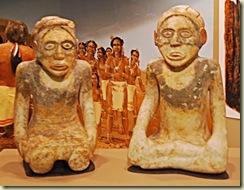 Today it’s raining and blustery outside. So let’s take the opportunity to look through the exhibits in the Etowah Mound Site Museum. First, though, a caveat. I forgot to bring a large tripod for the camera on this trip. So, since flash is forbidden, I’ve had to hand-hold Andrew’s huge camera in only moderate light throughout the museum. Not good! But a few of the photos may be sharp enough to display here. Sorry about that.
Today it’s raining and blustery outside. So let’s take the opportunity to look through the exhibits in the Etowah Mound Site Museum. First, though, a caveat. I forgot to bring a large tripod for the camera on this trip. So, since flash is forbidden, I’ve had to hand-hold Andrew’s huge camera in only moderate light throughout the museum. Not good! But a few of the photos may be sharp enough to display here. Sorry about that.
The two figures you see above are perhaps the best known from this site. Both are marble. Each weighs over 100 pounds. Both were found near the base of Mound C. Archeologists have learned much about personal dress and decoration at the time from these incredible figures.
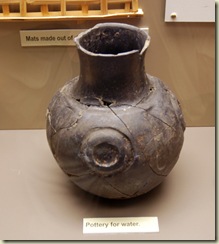 Not all of the pieces in this collection are as dramatic as the two marble figures above. Indeed, many, if not most, of them, are everyday objects, such as the water jar pictured above. Perhaps an everyday piece. But still tastefully decorated.
Not all of the pieces in this collection are as dramatic as the two marble figures above. Indeed, many, if not most, of them, are everyday objects, such as the water jar pictured above. Perhaps an everyday piece. But still tastefully decorated.
 And here’s an even more mundane piece. If that’s the word. A corn grinding stone. Probably used daily by one or more families to prepare their meals. Imagine how surprised the last owner of this grinding stone would be were she to learn that her simple tool would be preserved in a museum like this!
And here’s an even more mundane piece. If that’s the word. A corn grinding stone. Probably used daily by one or more families to prepare their meals. Imagine how surprised the last owner of this grinding stone would be were she to learn that her simple tool would be preserved in a museum like this!
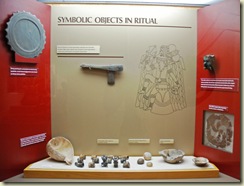 The collection includes interesting ritual objects as well. This photo doesn’t offer much detail, unfortunately. But the axe in the center is carved from one piece of stone. Clearly it was never intended for use other than ceremonial. The plate at the left too is carved from stone. It’s thought to have served as a palate for mixing the paints used for body decoration at ceremonial events. And the conch shell dipper at the left bottom is especially interesting. It’s from Florida, and was used as a ceremonial ladle. One more evidence of contact between this site and others at some distance.
The collection includes interesting ritual objects as well. This photo doesn’t offer much detail, unfortunately. But the axe in the center is carved from one piece of stone. Clearly it was never intended for use other than ceremonial. The plate at the left too is carved from stone. It’s thought to have served as a palate for mixing the paints used for body decoration at ceremonial events. And the conch shell dipper at the left bottom is especially interesting. It’s from Florida, and was used as a ceremonial ladle. One more evidence of contact between this site and others at some distance.
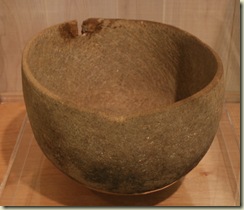 Here is a very special piece. A bowl from the late Archaic period. That’s somewhere between 8000 and 1000 BC! Quite a spread. But that’s what it says on the sign. Incredibly, it was discovered by a Bartow County farmer while plowing. It’s made of soapstone, or steatite, and shows evidence of use over a fire. A remarkable piece.
Here is a very special piece. A bowl from the late Archaic period. That’s somewhere between 8000 and 1000 BC! Quite a spread. But that’s what it says on the sign. Incredibly, it was discovered by a Bartow County farmer while plowing. It’s made of soapstone, or steatite, and shows evidence of use over a fire. A remarkable piece.
This museum is chuck-full of interesting objects and exhibits. And, as we saw at the Fort Walton Beach Museum, most of the pieces have been placed by the curators in context that makes them easier for non-archeologists to appreciate.
The photos I took here simply don’t do them justice. So, you’ll have to go to see them yourself. I’m certain you will appreciate what you find. If you intend to take photos, don’t forget the tripod! Good photos here will require quite long exposures!
Special thanks to the overworked staff of the Etowah Mound Site. Both employees and volunteers. DNR budget cuts have pared personnel and operating expenditures here to the bone. Yet the staff remains helpful and enthusiastic. Dedicated to their jobs, and to preservation of the site.
You know you’ve encountered a special group when you learn that one reception desk “volunteer” is actually a recently laid-off full-time employee! Working as usual. But now on a for-free volunteer basis. That’s dedication to the mission!
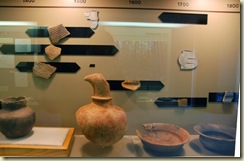 Here too, as at Ocmulgee and Fort Walton Beach, I was only able to scratch the surface of all the Site has to offer. There’s so much more here to learn, and to enjoy. I hope to return in the not too distant future after further study. And hope some of you in the meantime will be able to visit Etowah, Fort Walton Beach, and Ocmulgee. You won’t be disappointed!
Here too, as at Ocmulgee and Fort Walton Beach, I was only able to scratch the surface of all the Site has to offer. There’s so much more here to learn, and to enjoy. I hope to return in the not too distant future after further study. And hope some of you in the meantime will be able to visit Etowah, Fort Walton Beach, and Ocmulgee. You won’t be disappointed!
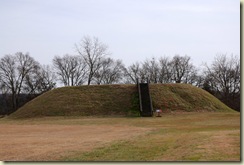
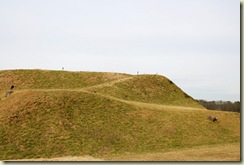

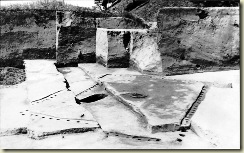
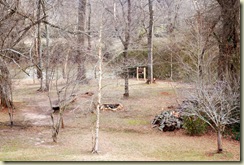
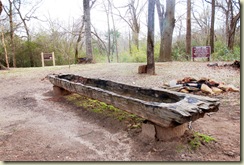
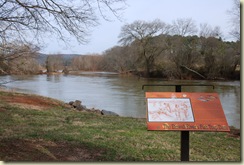


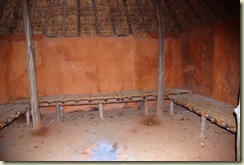
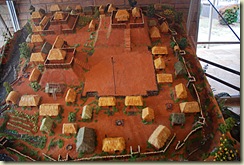
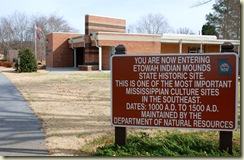
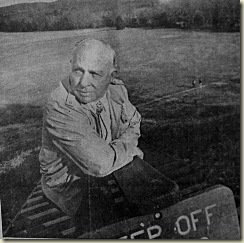


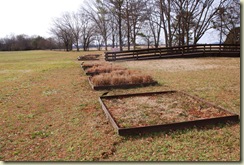
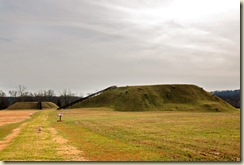
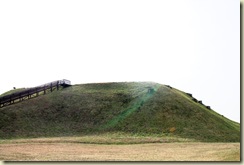
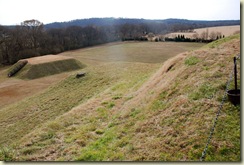
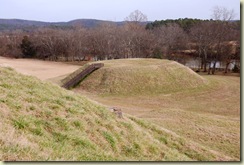

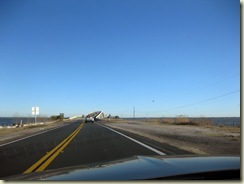
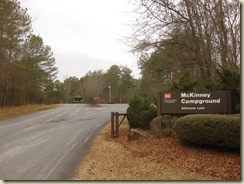 The McKinney Corps of Engineers Campground
The McKinney Corps of Engineers Campground